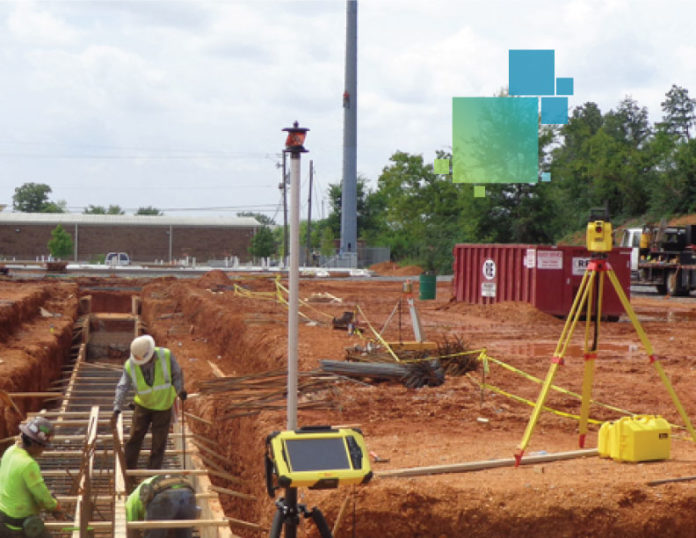For Sobcon Concrete, Inc., a full-service concrete contractor with clients all over Alabama, typical commercial projects once started with strings, tape measures, caulk lines and batter boards. “Our main work is forming and pouring concrete for foundations, retaining walls, columns and elevated slabs,” said Josh Hollingshead, Sobcon’s head project engineer. “Our crews do all of their own layout.”
These layouts – most of which are for major commercial projects – can take days to measure and process and are subject to human error and inaccuracies that can potentially cause expensive rework and delays. “Before, we would at least need the building corners set at a jobsite for us to even begin working. Then we would set the boards and start pulling distances with a tape measure and string,” said Hollingshead. “As our projects started getting bigger and covering larger areas, walking back and forth to pull those lines was becoming very time consuming, and the farther you are stretching the strings, the less accurate your measurements become.”
Robotic Total Stations Save Time and Money

A few months ago, a Leica Geosystems representative loaned Hollingshead a Leica iCON robot 50 robotic total station and iCON build software to try. “We jumped right in,” said Hollingshead. “We used the new system on a big retail project in Tuscaloosa – a new green space in the center of a large shopping center and surrounding sidewalks – and it helped us out a lot.”
Sobcon liked the new system so much that they have since purchased two. “I was pleased with how quickly the crews picked it up,” said Hollingshead. “I actually took the system home one weekend to get familiar with it, and it was very easy to use. Our crews had no trouble adapting.”
With the new system, Sobcon was able to bring the architectural drawings that showed all of the unusual patterns and recesses in the sidewalks into tablets and lay out the points digitally. “Using the robots cut our layout time in half,” said Hollingshead.
The company recently used its two robotic total stations on two large student housing projects on the University of Alabama’s campus. “Without the robots, this would have taken us three days to lay out. Now, we can do it in two days and it’s a lot more accurate,” said Hollingshead. “We routinely lay out at least 40% faster if not more, depending on the project – especially when we’re dealing with unusual angles that are very difficult to do by hand.”
Digital Layouts Easy to Use, Pay for Themselves

One of the biggest benefits, Holingshead says, is the iCON tablet’s visual representation and the robot itself, which allows one crew member to complete the layout as opposed to having one person run the instrument while another is holding the reflector and setting the point.
Workflow has also improved. Previously, the crew’s foreman was responsible for getting drawings to the jobsite, and work could not begin until the entire project had been completely laid out. Now, the field data is coordinated with the office using MicroSurvey Point Prep software. Once the crew is onsite, the robot can be set up quickly and actual work can begin much faster. Not only does this save time for crews in the field, but it also makes their job easier, which helped ease their transition to using robotic tools. “I can now take the drawings from the field and put them into MicroSurvey Point Prep, check the points, make revisions, and then send all of that information back to the tablet,” said Hollingshead. “Instead of crews having to carry and flip through a set of drawings to find dimensions to incorporate into their batter board and string layout, they now have everything they need right there on the tablet. It saves a ton of time.”
It also saves a lot of money. “The system has paid for itself in two jobs,” said Hollingshead. “We bought two of them at the same time – one for each of the jobs we were working on. Now, it’s hard to keep everyone on our five crews happy because everyone wants to use them.”
Sobcon plans to purchase at least two additional robotic total stations in the near future so that more crews will have access to the technology. “These systems have made everything more efficient,” said Hollingshead, “which ultimately saves time and money for both our crews and our customers.”

Go here to learn more about construction layout solutions for concrete contractors.






